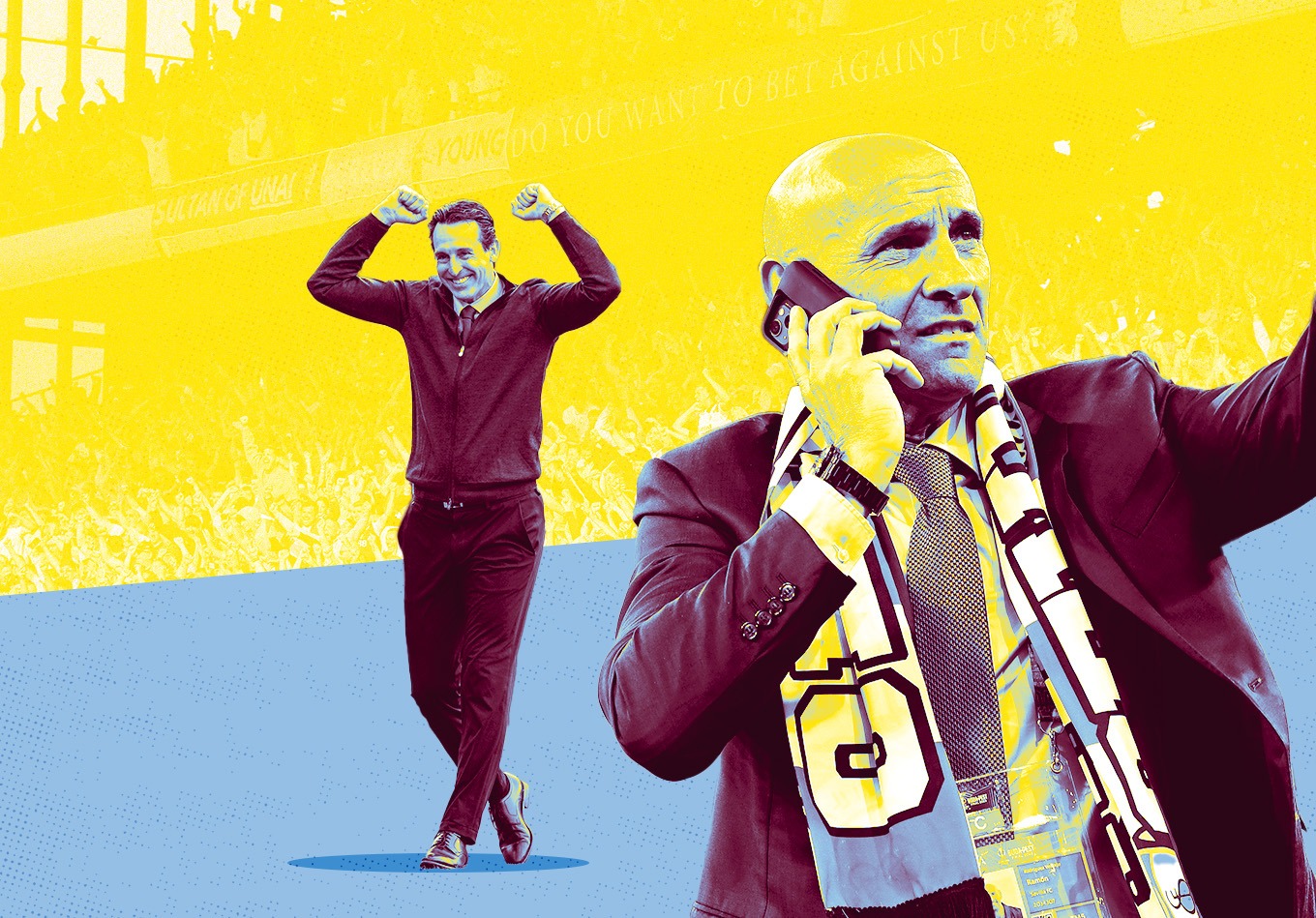Unai Emery and Monchi were once a brilliant partnership at Sevilla; now, they’ve been charged with taking Aston Villa to the next level.
No one expects the Spanish inquisition, least of all the people of the West Midlands. But there’s an unmistakable new aura to Aston Villa, or Aston Sevilla as they’ve been dubbed by some.
Managing to lure Unai Emery to Villa Park was considered something of a coup in itself; that pales in comparison to now pairing him with the man he worked alongside so effectively for nearly three and a half years at Sevilla.
Monchi brought his second spell as Sevilla sporting director to an end in mid-June as his move to Villa was made official just a few weeks on from his former club lifting the Europa League (or UEFA Cup) for a seventh time.
All seven of those triumphs were on Monchi’s watch, having transformed the club since the former Sevilla goalkeeper was first hired as sporting director in 2000. But this latest Europa League success was unlike any of the previous six; they’d all been enveloped in positivity and optimism, as if each one was the start of a glorious new era.
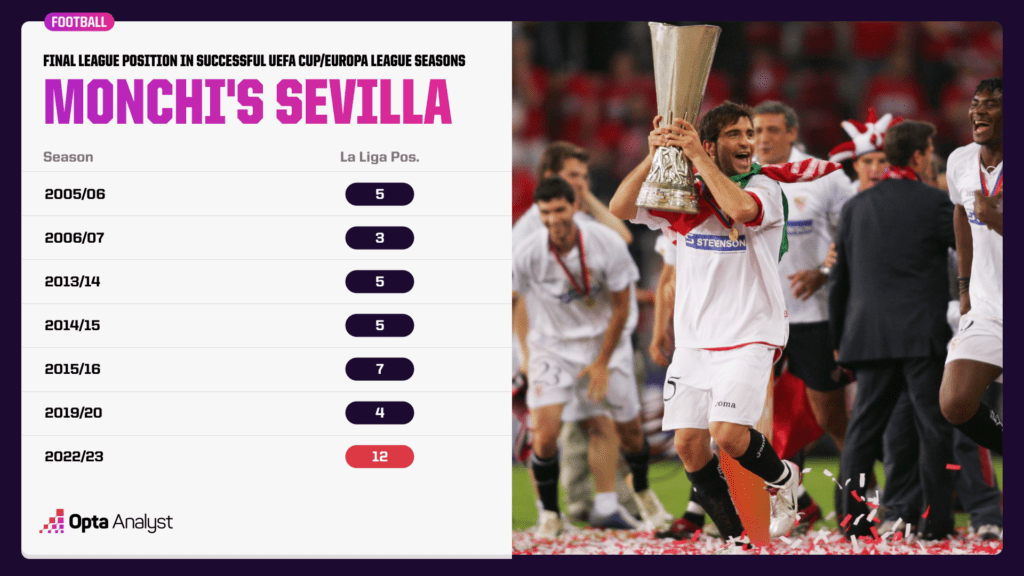
While supporters undoubtedly enjoyed the penalty shootout defeat of Roma in Budapest back in May and were out in force at the Puerta de Jerez fountain in Sevilla as they always are whenever the club wins a trophy, the glory was set against a more concerning backdrop. They’d flirted with relegation not long prior; the standard of the squad built by Monchi had been criticised all season long; the club’s finances are not in great shape; and doubts over the future of the revered transfer guru had begun to take root.
It was a gruelling, emotionally draining season for Sevilla and Monchi. For him, a separation made sense. Aston Villa is, in a way, the perfect next step in that they offer familiarity, ambition and significant room for growth.
The Dynamic Duo
The band is back together again. Monchi and Emery were a fine double act at the Ramón Sánchez Pizjuán, winning three Europa League titles back-to-back between January 2013 and June 2016.
Now there’s a half-tongue-in-cheek-half-serious acceptance Sevilla will win the Europa League every year they’re in it, but the club’s outlook when Emery and Monchi first started working together 10 and a half years ago was rather bleaker.
Sevilla weren’t the force they’d been in the previous decade, with the ninth-placed finish in 2011-12 being the second-lowest final position since promotion in 2001. Between the start of 2010 and the January 2013 hiring of Emery, club legend Manolo Jiménez, Antonio Álvarez, Gregorio Manzano, Marcelino García Toral and Míchel were all dismissed – only Jiménez lasted more than a year as head coach.
Sure, Emery inherited a squad that had talent in it. Federico Fazio, Jesús Navas, Gary Medel, Álvaro Negredo, Diego Perotti, Ivan Rakitić, José Antonio Reyes and Geoffrey Kondogbia were all there, but even among that group there were players who were underperforming or persistently unavailable due to injury.
The 2012-13 season culminated in another ninth-place finish. The final game of the season, a thrilling 4-3 home win over Emery’s former club Valencia, had an end-of-an-era feel to it. Long-serving goalkeeper Andrés Palop was retiring; local boy Navas waved farewell with his move to Manchester City done and to be announced the following day; Negredo followed him to the Etihad Stadium, and Kondogbia and Gary Medel would be among the others sold on as well.
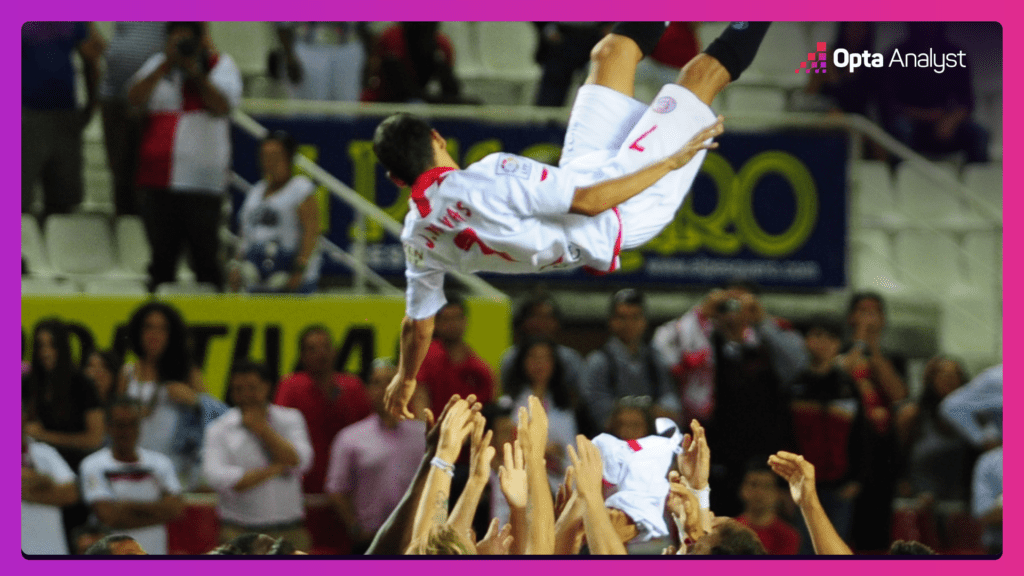
Luckily for Sevilla, however, Málaga and Rayo Vallecano were barred from competing in Europe the following season, meaning Monchi was charged with building a squad capable of battling on multiple fronts despite the disappointing final league position.
For many fans, the work conducted by the sporting director in the summer of 2013 was his best.
No fewer than 14 players arrived, with Carlos Bacca at roughly €10 million being the most expensive. An estimated total outlay of €35m was bankrolled by outgoings worth about €90m, and some of their pick-ups could still be regarded as among Monchi’s best signings ever. Bacca, Kévin Gameiro and Vitolo all went on to secure Sevilla significant profits, while Stéphane Mbia, Nico Pareja and Daniel Carriço became fan favourites.
Monchi has often been considered the chief inspiration for many of Sevilla’s successes, and that is understandable given the key decisions and squad building always came back to him, but it’s difficult to look back on 2013-14 and not hold Emery up as the difference maker. The squad turnover was remarkable, and yet the Basque coach quickly turned them into a cohesive unit that went on to not only finish fifth, but also win the Europa League thanks to a penalty shootout defeat of Benfica in the final.
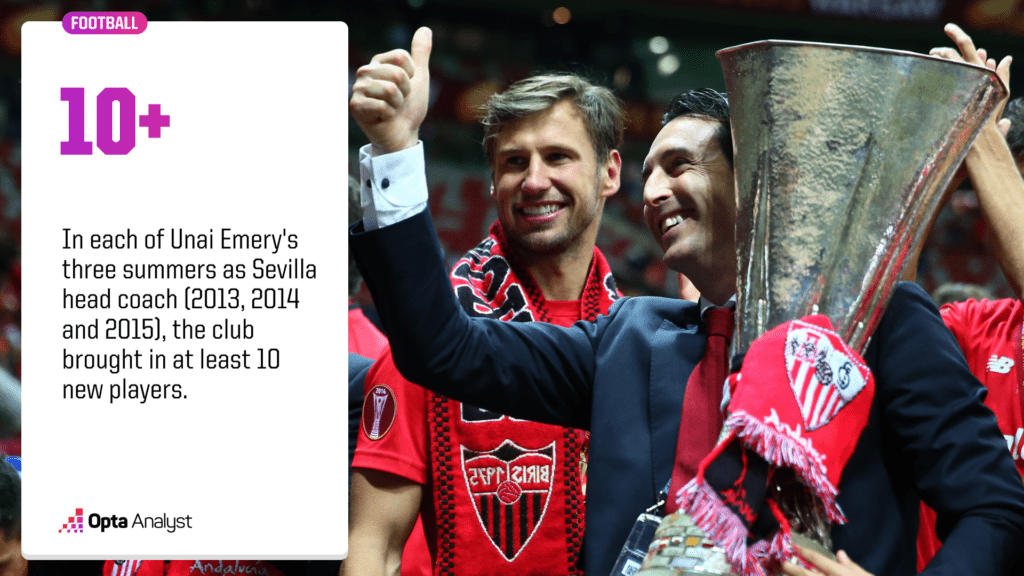
“He has clear ideas,” Monchi said of Emery in late 2013. “Sometimes we can agree on them, sometimes not. My worry was that I wasn’t convinced about [Emery’s ideas], but [now] there are no doubts. He could have built a team that sat back, but then that is not Unai. He thinks – and in this respect he is very similar to Juande Ramos – that it is better to win 4-3 than 1-0. The only thing I ask of a coach is clarity of ideas, and he is very clear.”
Some players can’t handle that clarity. During his days at Almería, with whom Emery had a first taste of La Liga management by earning promotion, it was said his obsession with video analysis put some individuals to sleep. But at Sevilla, players mostly thrived under his leadership. Vitolo had been plucked from the Segunda; Carriço couldn’t get first-team football at Reading; Éver Banega appeared close to squandering his incredible potential; Aleix Vidal, Grzegorz Krychowiak and Steven Nzonzi were all signed relatively cheaply and reached levels they’d never see again after being sold for big profits.
Monchi was certainly due his share of the credit, but it was Emery providing the clarity in terms of type of players he wanted, and then moulding those individuals into a team. In all three summers Emery spent at Sevilla, the club brought in at least 10 new players – and that excludes those who came up through the youth system. Yet, the Europa League trophies kept coming. “He is the most complete coach of all the ones I have ever had,” Monchi declared.
They defeated Dnipro in Warsaw in 2015 to move on to a record four successes in Europe’s secondary competition, then beating Jürgen Klopp’s Liverpool a year later to fittingly become the first team to qualify for the Champions League by winning the Europa League. It was a glorious period, but at a club like Sevilla, such spells can only last so long before the masterminds move on. The lure of PSG was too great for Emery.
The Fall
Monchi attempted leave the same summer as Emery, but the club wouldn’t allow it. Less than a year later, in April 2017, his wish was granted; a brave new quest began in Rome.
Jim Pallotta, Roma owner at the time, was thrilled with the hire: “I couldn’t be happier with this appointment as Monchi is widely regarded as one of the best minds in world football.”
Monchi resigned a little under two years later, his sojourn in Italy an unmitigated failure. Pallotta, reflecting on that spell in a 2021 interview with The Athletic, said: “You look at that whole body of work. We were like, ‘those were expensive mistakes’.”
In fairness, Roma finished third in Serie A and reached the Champions League semi-finals during Monchi’s first full season in charge, making it five successive top-three finishes for the first time in Roma’s history. But it was the following summer that continues to haunt him.
Roma had to sell certain assets – such as Mohamed Salah and Alisson – for financial reasons, but the players who came in largely disappointed. Over €100m was spent on Patrik Schick, Steven Nzonzi, Javier Pastore and Justin Kluivert. The only one of those to play more than 60 matches for Roma across all competitions was the latter (68), who they’ve only just managed to sell to Bournemouth five years on.
Lorenzo Pellegrini and Bryan Cristante could be considered two of few success stories among those Monchi signed – Nicolò Zaniolo technically fell on his watch, though his signing was secured by Franco Baldini, not Monchi. There were many more failures, on top of those already mentioned. Maxime Gonalons, Gregoire Defrel, Mário Rui, Héctor Moreno, Ante Coric and Jonathan Silva all played no more than 23 games.
Despite the optics of Monchi’s time in Rome, he nearly linked up again with Emery almost immediately. Who knows, had he done so, Emery’s time at Arsenal might have gone very differently – that’s right, Monchi had essentially agreed a deal to move to the Emirates Stadium in 2019. Emery was even asked about it in a press conference. “I worked very well with him in Sevilla for three and a half years,” he said. “My relationship with him is good but this work is for the club and the issue is the club’s responsibility. I can say to you only that he is a good person and a good professional.”
But Sevilla came calling and managed to persuade him to return home. “I thank Arsenal for their interest,” Monchi said. “They’ve been the club who have shown the most interest in me but, in the end, I evaluated all of the offers I had on the table and I chose the one that convinced me most. I had other options, and very important ones that were flashier, but I’ve chosen Sevilla because its sporting project convinced me.”
The project? To turn Sevilla into “a team that can fight among the best”. Another rebuild began. As coach he hired a Julen Lopetegui with a point to prove. That season brought a fourth-place finish, plus another Europa League title. Then, in 2020-21, Sevilla were genuine title challengers for much of the season before fading away in the final weeks of the campaign – but they still broke their club record for most points in a top-flight season (77). That would be their peak; a third consecutive top-four finish – something they’d not managed since the 1950s – was achieved in 2021-22, but that was essentially the end of the cycle.
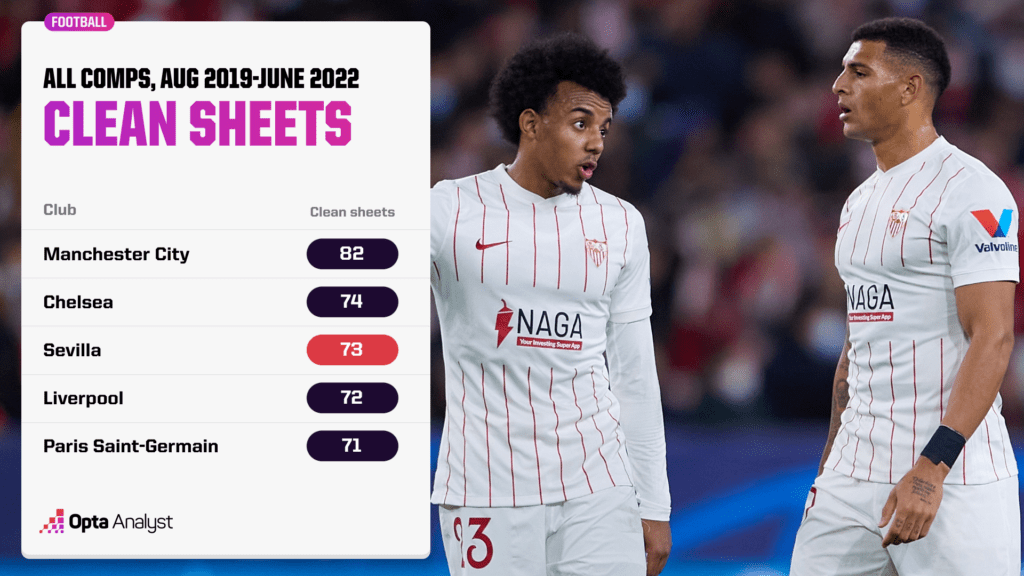
The bedrock of the Sevilla team that nearly upset the established order was torn apart with the necessary sales of Diego Carlos and Jules Koundé. Monchi arguably achieved the goal he set out towards, but the squad planning ahead of the 2022-23 season was dire. Quite how José Luis Mendilibar guided them to a seventh Europa League crown is a mystery and certainly doesn’t tell the story of their campaign; when he was hired in March, Sevilla were genuinely relegation candidates. Their final position of 12th was a huge slide from fourth that only Valencia (also fourth in 2014/15 to 12th in 2015/16) have managed in recent years.
Monchi decided to leave. A rest is what he craved, but then a certain opportunity arose – this time he couldn’t turn it down.
Reunited
Villa were 17th in the Premier League when Steven Gerrard was sacked in late October. Emery’s first game in charge was on November 6. Between the start of that weekend and the end of the season, only four teams won more points than Villa (49), who played one game less than their rivals.
Their 1.96 points per game was identical to Liverpool’s over that period and bettered only by champions Manchester City (2.31), Arsenal (2.04) and Manchester United (2.0). It was another rapid and astonishing turnaround inspired by Emery.
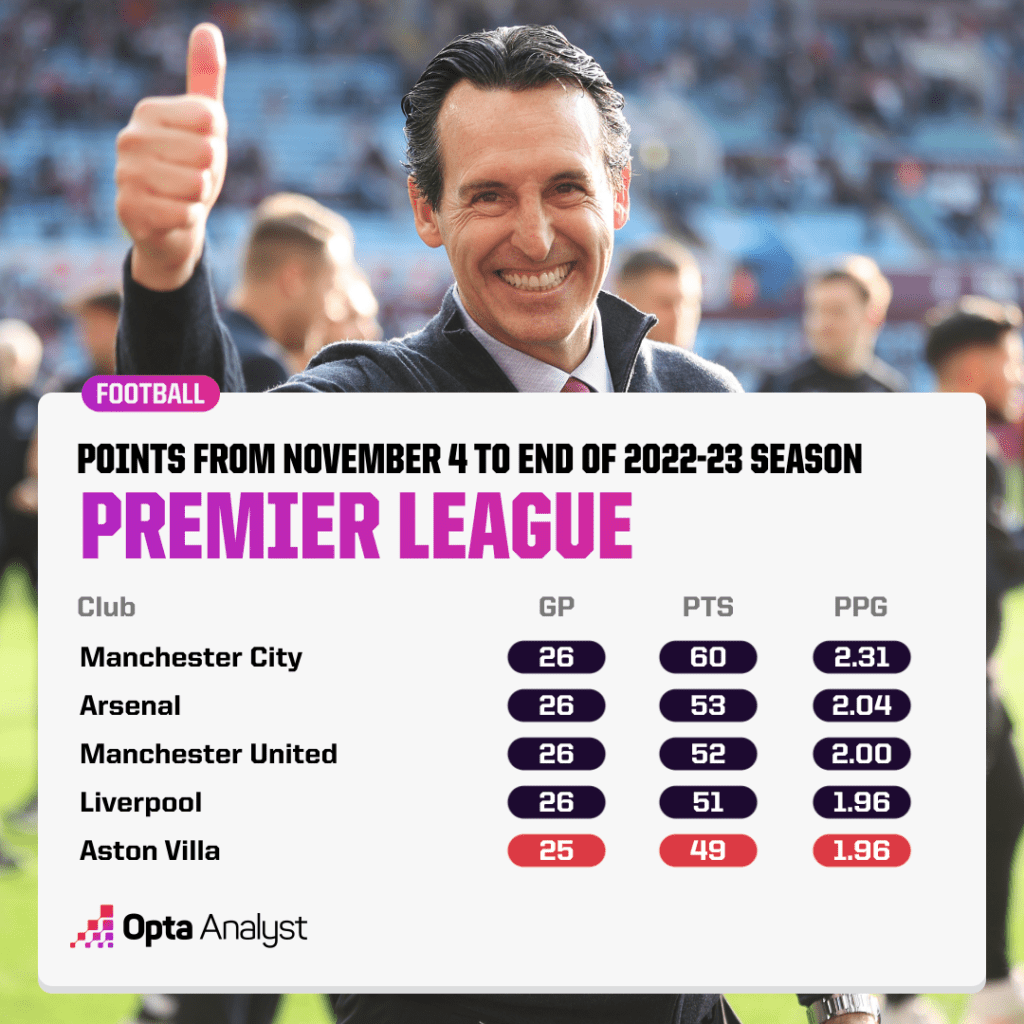
His reputation took something of a battering at Paris Saint-Germain and then Arsenal, but he was up to his usual tricks again with Villarreal, winning the Europa League for a record fourth time with their 2021 penalties defeat of Manchester United.
Villarreal’s European exploits over those two years in charge, plus his brilliant start at Villa, have gone a long way to correcting the perceptions of Emery from those spells at PSG and Arsenal, but how much more is there to come? This is obviously a very difficult – impossible? – question to answer, however we have to at least consider his record in league competitions.
In the last 10 years, the only club he’s managed to guide to a top-four finish is PSG. Of course, he’s done well in knockout competitions; on top those successes mentioned before, he also took Arsenal to the Europa League final and led Villarreal to the last four in the Champions League in 2021-22. But even his Europa League three-peat Sevilla side never finished higher than fifth in La Liga, while he guided Villarreal to back-to-back seventh-place finishes.
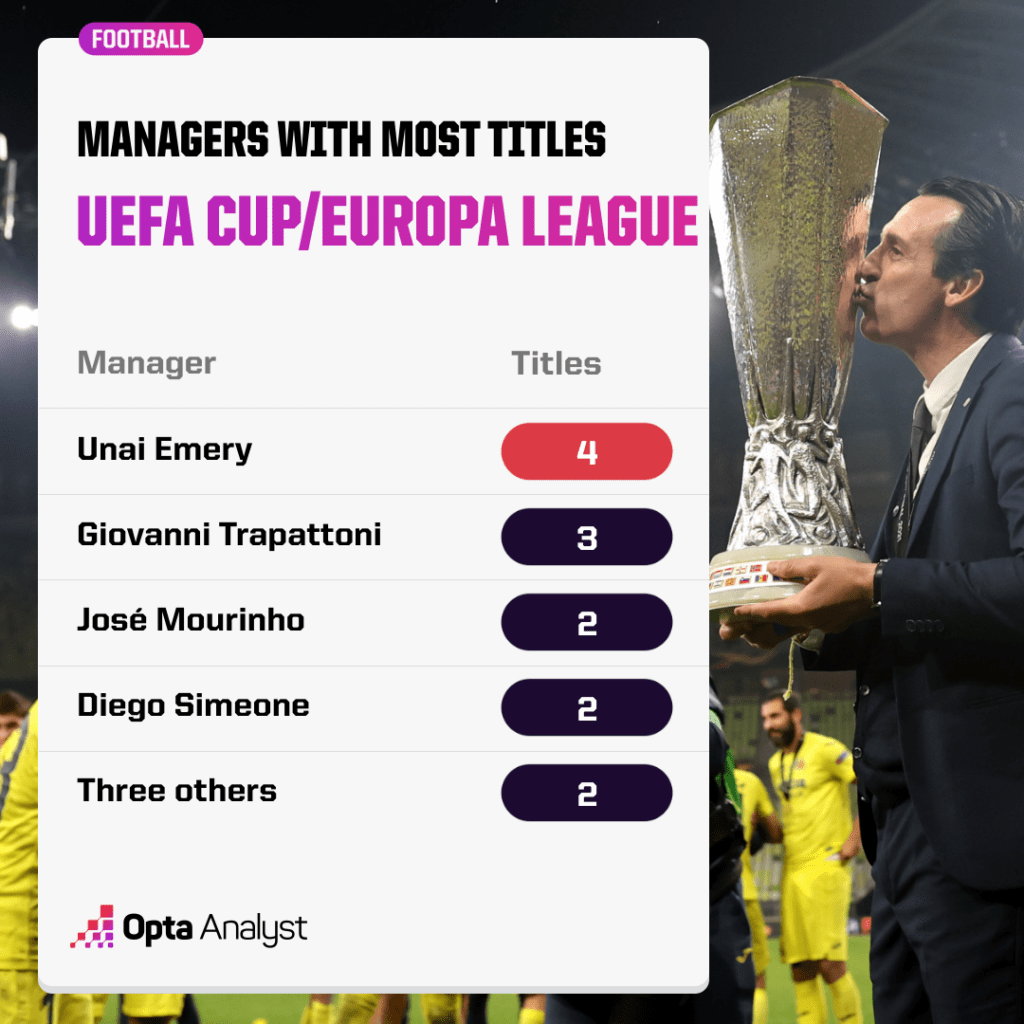
But in each case with Sevilla and Villarreal, you could suggest their focus was justifiably on European success, and realistically only the very deepest squads would be able to maintain a very high level on multiple fronts all season.
Emery’s start at Villa backs this up. They didn’t have a European campaign to worry about, so distractions were at a minimum and recharging time was maximised. They will be in the Europa Conference League next term, however. While prioritising the Premier League might seem obvious, the additional competition will certainly stretch their squad.
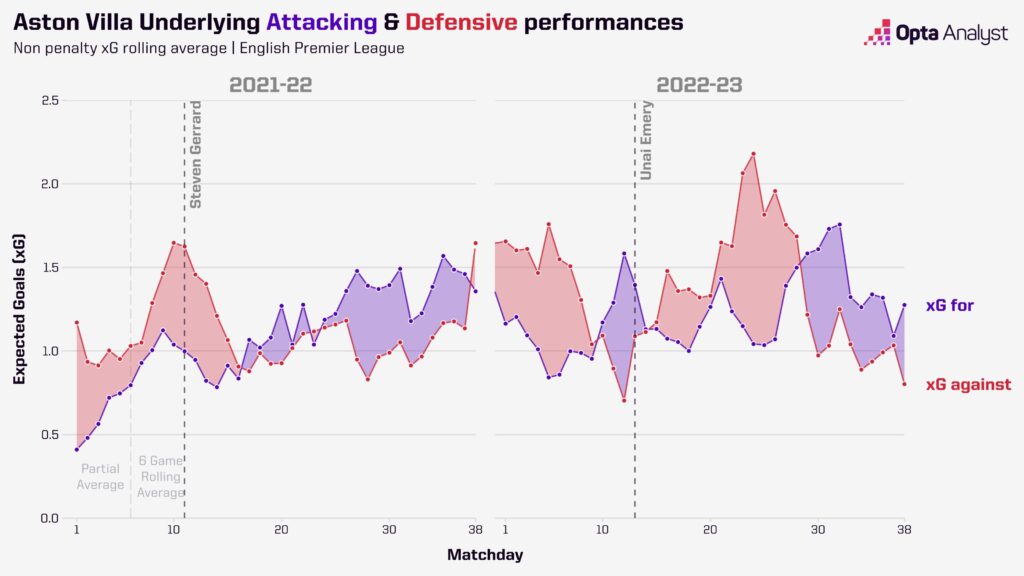
Villa’s potential shouldn’t be downplayed, though. Emery showed the impact he can have by himself last season. He is a very good coach, and he’s now once again paired with the man who’s arguably been the best talent spotter in Europe this century, someone with whom he’s thrived before. Granted, the context now is significantly different. Villa’s owners are ambitious; their model isn’t necessarily going to revolve around buying rough diamonds and polishing them to sell at a profit – and then doing that all over again. No, the money is already there, they just needed a double act to identify and develop talent.
In Emery and Monchi, there’s no doubt they have two people who’ve excelled in those areas both as a partnership and exclusively, and on a consistent basis. The latter’s Roman misadventure and the 2022 pre-season may concern some, but a couple of bad summers shouldn’t overshadow countless brilliant ones. For every Pastore there’s a Rakitić and a Banega; for every Isco there’s a Dani Alves, a Koundé.
Teaming Emery up with Monchi certainly isn’t a guarantee of success, but it’s a huge statement of intent.
Enjoy this? Subscribe to our mailing list to receive exclusive weekly content. And follow us on Twitter too.
